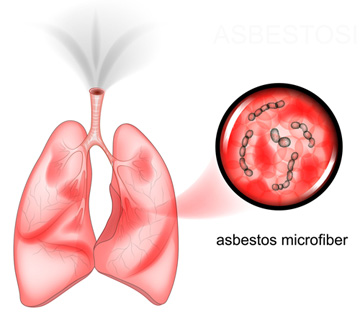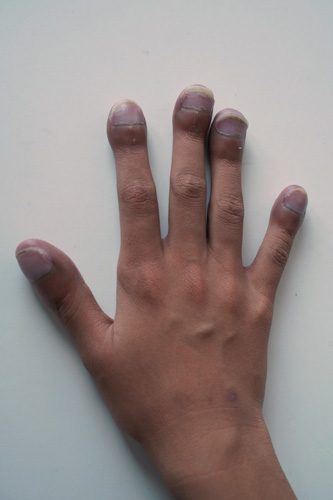Free Case Evaluation
You will never be charged a fee unless a recovery is made for you.

Asbestosis is a disabling, debilitating, sometimes fatal lung disease caused by inhaling asbestos fibers. When asbestos fibers are inhaled, they can cause inflammation and scarring in the lung tissue. It usually takes from 10 to 40 or more years after exposure to asbestos for the effects of asbestosis to become apparent.
Individuals with asbestosis or their families and loved ones may file a lawsuit to receive compensation for their medical bills and pain and suffering from the manufacturer of the products that exposed them to the asbestos fibers or the employer that did not adequately warn and protect them. If you are considering filing an asbestosis lawsuit, contact us. We have access to the expertise, resources, and manpower to fully investigate each case and to track down and hold accountable those responsible for the exposure that lead to you developing asbestosis. Our experienced attorneys take a personalized, compassionate approach. We cut through the legalese and partner with our clients.
You can call us at 800-796-1636 or submit your case details online. Someone will contact you shortly to discuss your history, your illness, and ways in which we may be able to help you. The consultation is free. We only receive compensation if you win your case.

The only cause and risk factor for asbestosis is exposure to asbestos over time. While the use of asbestos in the United States has dropped significantly since the 1970s, it is still present in older buildings and homes that were built before its dangers were known and some of its uses banned. And asbestos is still used in products such as car brakes and roofing materials.
The most at-risk trades and professions for asbestos exposure are construction, plumbers, electricians, firefighters, and shipbuilders. Veterans are also on a short list of occupations that experienced increased exposure due to asbestos use in ships, among other factors.
Products and materials that may contain asbestos include:
If you go to your doctor with breathing problems, they will probably begin by listening to your lungs and also evaluating your breathing while you are at rest and during activity. They will also ask about your job history and life experiences, to determine if and when you may have been exposed to asbestos, and take a full medical history. Smoking history will also be relevant and discussed.
Tests that may be performed include a chest x-ray or CT scan and a lung function test.
If these tests show evidence of scarring in the lungs, a biopsy might be performed. A biopsy involves removing a small sample of lung tissue for analysis.
Asbestosis is a noncancerous debilitating lung disease that can develop after repeated exposure to asbestos. When asbestos is inhaled, some of the asbestos fibers may become lodged in tiny sacs in the lungs called alveoli. The alveoli are where carbon dioxide is exchanged for oxygen for your blood. The asbestos fibers can irritate and inflame the lung tissue, creating scar tissue. This is called fibrosis.
The scar tissue makes the lungs stiff, which makes it difficult to breathe. As asbestosis progresses, the scarring in the lungs spreads and increases, making the lungs increasingly stiff until they can’t expand and contract normally.
Smoking cigarettes may increase the progression of asbestosis by increasing the retention of the fibers in the lungs. In addition, smokers with a history of asbestos exposure are at high risk of developing lung cancer.

Symptoms of asbestosis include:
The only cause and risk factor for asbestosis is exposure to asbestos over time. While the use of asbestos in the United States has dropped significantly since the 1970s, it is still present in older buildings and homes that were built before its dangers were known and some of its uses banned. And asbestos is still used in products such as car brakes and roofing materials.
The most at-risk trades and professions for asbestos exposure are construction, plumbers, electricians, firefighters, and shipbuilders. Veterans are also on a short list of occupations that experienced increased exposure due to asbestos use in ships, among other factors.
Products and materials that may contain asbestos include:
If you go to your doctor with breathing problems, they will probably begin by listening to your lungs and also evaluating your breathing while you are at rest and during activity. They will also ask about your job history and life experiences, to determine if and when you may have been exposed to asbestos, and take a full medical history. Smoking history will also be relevant and discussed.
Tests that may be performed include a chest x-ray or CT scan and a lung function test.
If these tests show evidence of scarring in the lungs, a biopsy might be performed. A biopsy involves removing a small sample of lung tissue for analysis.
There is no cure for asbestosis, and there is no way to reverse lung damage caused by asbestosis. However, there are steps you can take to slow its progression, and your doctor will prescribe treatments to help your breathing.
First and foremost, if there is an asbestos source you are still being exposed to, you should immediately avoid that source. Furthermore, if you smoke cigarettes, you should quit. Your doctor can provide resources and perhaps medicine to help you quit smoking.
There are also treatments that can help your breathing. An aerosol medicine or medicines may be prescribed to thin the fluids in your lungs. If your breathing is sufficiently impaired, your doctor may prescribe oxygen—either by a tube that fits in your nostrils or a mask. Pulmonary rehabilitation, which is an exercise program to help patients with lung conditions, may be recommended. In severe cases, a lung transplant may be discussed.
Sources
You will never be charged a fee unless a recovery is made for you.